Amidst the rush of modern life, which moves at a relentless pace, there are certainly a few treasures. Some are deeply woven into the fabric of culture, that endure as timeless symbols of craftsmanship, luxury, and heritage. Pashmina, the exquisite art form originating from the mystical terrains of the Himalayas, is one such treasure. This is a story that encapsulates centuries of tradition, artistry, and culture, carried through generations by artisans. In fact, these immensely skilful individuals have transformed a rare and precious fibre into the world's most coveted textile.
Cultural Significance of Pashmina: An Art of Legends
Pashmina is the art of creating luxury accessories and apparel from Cashmere wool. The word Pashmina resonates with luxury, comfort, and warmth. Additionally, it holds profound cultural significance in the regions where it's meticulously crafted. This unique art traces its origins to ancient times. In fact, its history mirrors the rise and fall of empires, trade routes, and artistic movements. From the high-altitude villages of Kashmir to the Tibetan plateau, Pashmina has served as a symbol of prestige. This is besides it being a mark of royalty and a testament to the enduring legacy of artisanal craftsmanship.
As Pashmina continues to lead the most luxurious art forms of the world, we try to unveil the secrets of its creation. So we delve in and discover the ancient techniques that render it unmatched in softness and warmth. We also try and immerse ourselves in the cultural celebrations where Pashmina plays a pivotal role. Moreover, let's hear the echoes of family traditions and the challenges artisans have faced, and continue to overcome, in preserving their heritage.
The Origins of Pashmina
Pashmina's story begins centuries ago, in the heart of the Himalayas. The exact origins of this exceptional wool may be shrouded in the mists of time. But its presence can be traced back to the ancient traditions of the region. Artefacts and manuscripts attest to the use of Cashmere wool dating as far back as the 3rd century BC. This was when it graced the royal courts and monasteries.
The Kashmir Connection: Where Culture Meets Pashmina
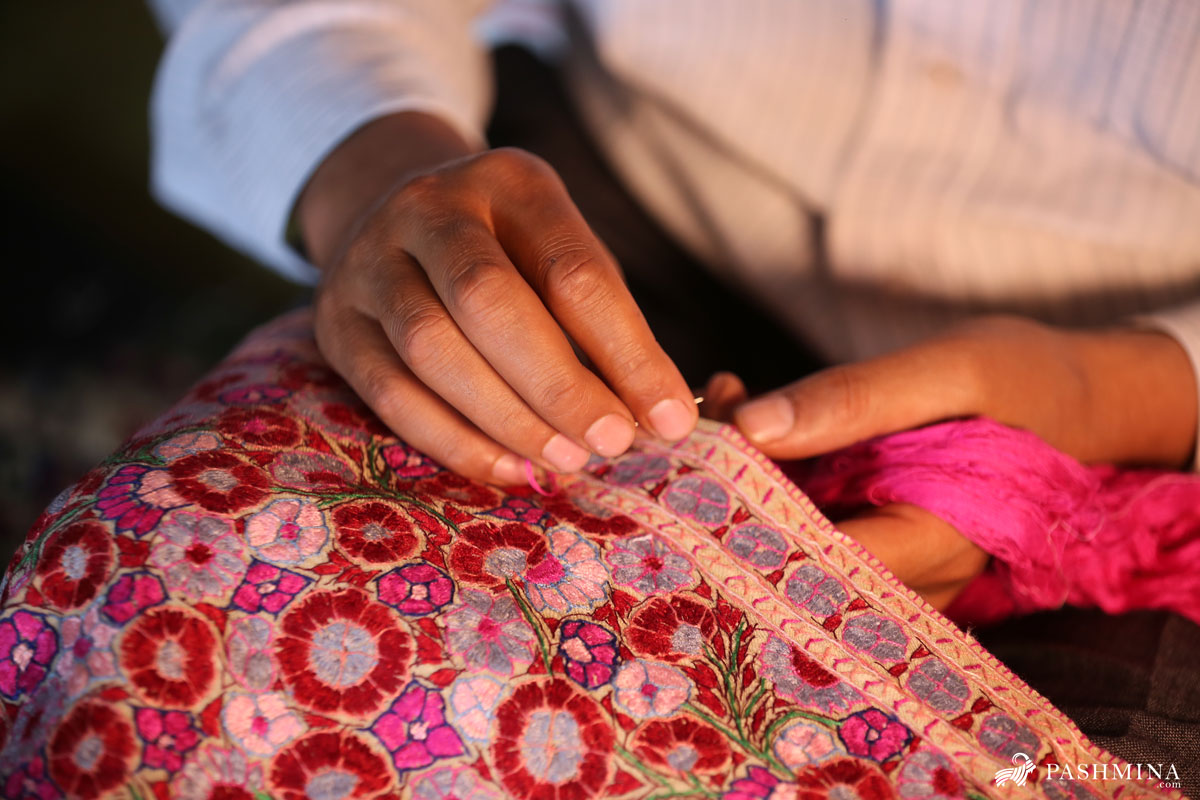
However, it is in the pristine valleys of Kashmir that Pashmina finds its most celebrated home. Famous as "Cashmere" in the Western world, the name itself comes from the region, hence demonstrating its profound influence on cultures far and wide. Kashmir has a unique place in the history of Pashmina, as the Cashmere wool transformation into exquisite shawls and scarves reached its pinnacle here.
A Symbol of Prestige and Royalty
In the vibrant tapestry of Kashmiri culture, Pashmina stands as a symbol of prestige and luxury. The art of weaving Pashmina shawls was not just a craft. In fact, it was an art that graced the lives of kings and queens, and its craftsmanship was revered far beyond the valley. These meticulously woven masterpieces of art were highly sought after in the courts of India, Persia, and beyond. Pashmina became an integral part of the royal attire, symbolizing not only the region's opulence but also the timeless connection between heritage and luxury.
The Impact of Pashmina on Culture and Identity
The impact of Pashmina on cultures transcends its tangible worth. It has woven itself into the very identity of regions like Kashmir, where it is an emblem of tradition and pride. The fine, soft Cashmere wool is not just a textile but a symbol of the enduring spirit of artisanship and heritage.
Pashmina's journey across centuries and continents underscores its significance. It connects regions, transcends cultures, and unites generations. It is not just an artwork, but a piece of living history that continues to shape the cultural landscape of the Himalayan foothills and beyond.
The Pashmina Artisans
The art of creating Pashmina products is a meticulous and labour-intensive process. And it has now come down through the ages. From harvesting the wool to weaving intricate patterns, it is the artisans who breathe life into this precious material. It is their skilled hands and unwavering dedication that are the threads connecting the past with the present.
Pashmina is more than just a textile; it is a living testament to the heritage of the Himalayan region. Artisans play a vital role in preserving the cultural significance. Hence, they are not merely weavers, but storytellers, narrating the tales of their ancestors through each delicate thread. It's a tradition that extends beyond craftsmanship; it is a commitment to safeguarding the unique identity of Pashmina.
The Artisan's Journey
Behind every Pashmina product lies the story of an artisan, whose journey is nothing short of extraordinary. The process begins with the collection of the finest Chyangra wool during the spring moulting season, where artisans display their deep knowledge of the craft by selecting only the most pristine fibres.
Once in the artisans' capable hands, the wool undergoes a metamorphosis. It is de-haired, spun, and dyed to perfection. The weaving process, often done on handlooms, is where their artistry truly shines. This intricate process involves creating patterns, be it traditional motifs or contemporary designs, all by hand. Hence, the end result is a product that encapsulates the essence of the artisan's skill and the cultural heritage of the region.
Stories of Dedication
Amidst the enchanting landscape of the Himalayas, artisans toil with patience and devotion. Their stories are often tales of inherited skills and lifelong commitments to their craft. These artists take immense pride in being part of a tradition that dates back centuries. Therefore, they are not just weavers; but bearers of history.
The significance of these artisans extends beyond their role in creating beautiful Pashmina products. They are weavers of cultural tapestries, stitching together a vibrant narrative that binds the past to the present. Each Pashmina product they create is more than just an accessory. It is indeed a piece of living heritage.
The Craftsmanship Behind Pashmina
At the heart of the Pashmina legacy lies the art of craftsmanship, a labour-intensive and intricate process that transforms the softest Changthangi wool into exquisite products. This craftsmanship is the bridge between tradition and innovation. Furthermore, it's a testament to the dedication of artisans who have perfected their skills over generations.
The Delicate De-Hairing
To begin with, the journey starts with the collection of the fine Cashmere wool. This wool, one of the finest in the world, is painstakingly handpicked, ensuring only the most superior fibres are selected. Later, de-hairing takes place, and the remaining fibres are cleaned and aligned, setting the stage for the creation of Pashmina yarn.
The Art of Spinning
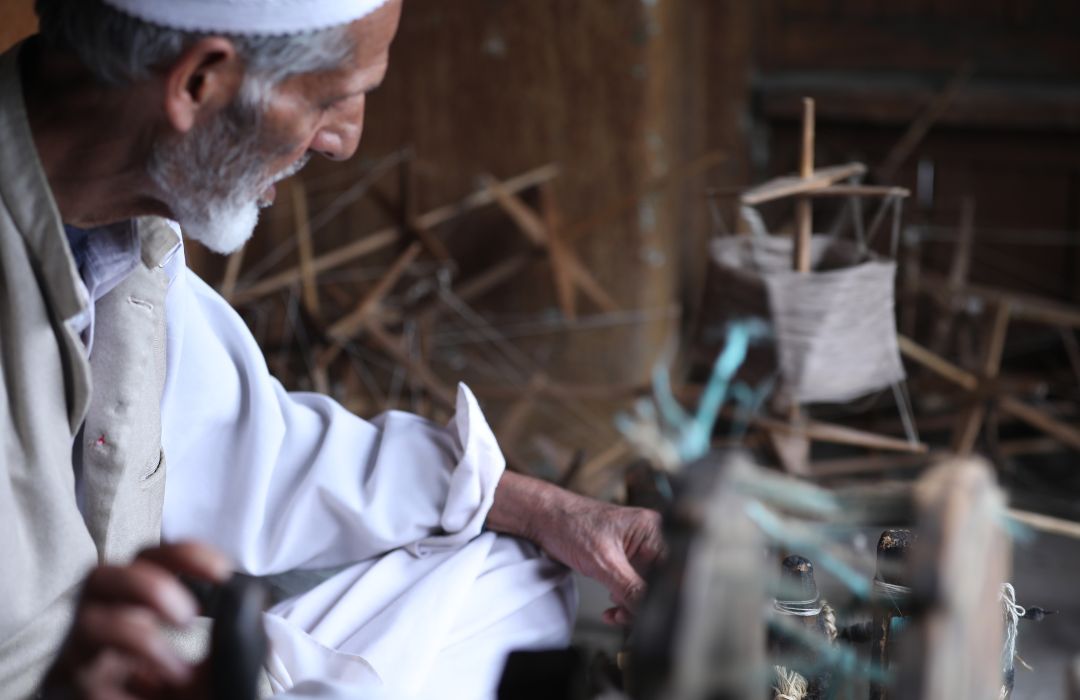
Pashmina yarn is crafted by hand-spinning the selected fibres into delicate threads. This process is both an art and a science, requiring precision and experience. Subsequently, the quality of the spun yarn determines the softness and warmth of the final product.
Dyeing and Colour Creation
Pashmina is popular for its vivid and timeless colours. Artisans use natural and synthetic dyes to imbue the yarn with the hues that will bring life to the final piece. This step requires a deep understanding of colours because slight variations can have a significant impact on the final product.
The Weaving Process
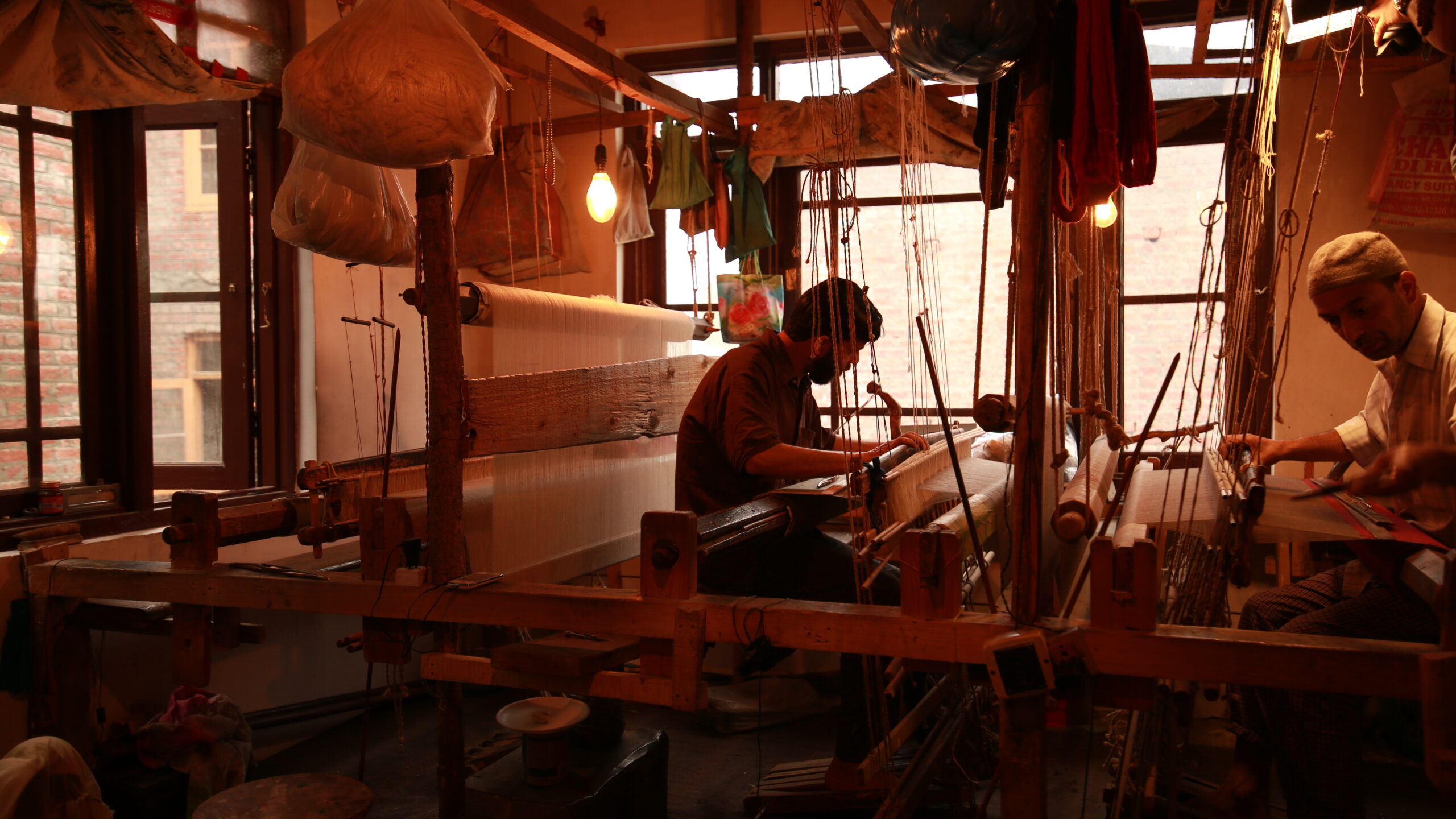
The weaving of Pashmina is a painstaking and time-consuming process. The yarn, now dyed and ready, is meticulously woven into intricate patterns. Some artisans adhere to traditional designs passed down through generations, while others innovate to create contemporary styles. The weaving process can take months or even years for a single piece, depending on the intricacy of the design.
Hand Embroidery
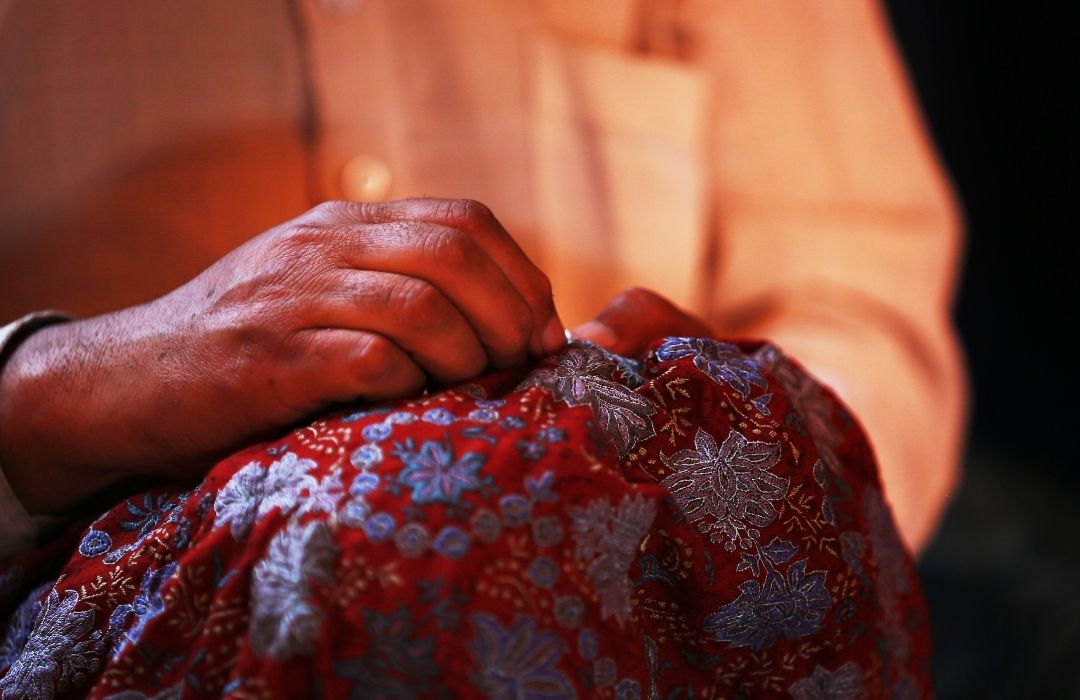
Pashmina shawls often feature intricate hand embroidery, adding a layer of artistry to the craftsmanship. These details are not just embellishments but stories in stitches, often representing elements of nature or cultural motifs. The skilled hands of artisans bring these designs to life, giving each Pashmina product a unique and personal touch.
Tradition and Innovation
While the traditional craftsmanship of Pashmina remains steadfast, artisans also adapt to the demands of the contemporary world. Innovative techniques and designs cater to changing tastes, ensuring that Pashmina remains relevant in the global fashion landscape.
The remarkable craftsmanship behind Pashmina products comes with a price, not just in monetary terms but in the dedication, patience, and expertise of the artisans. Pashmina is a testament to the artistry and skills of these craftsmen, who work diligently to ensure that each piece is not just a product, but a masterpiece.
Family Traditions
The world of Pashmina is not just about yarns and looms, but a legacy passed down through generations. At the heart of this cultural heritage are family traditions that bind artisans to their craft and ensure the continued existence of the Pashmina art.
Generations of Expertise
In the high-altitude regions of the Himalayas, where Pashmina is king, the knowledge of this craft is passed from one generation to the next. Young apprentices, often family members, start learning the art at a tender age. They observe, assist, and practice alongside their elders, imbibing not just the techniques but the reverence for the craft itself.
The Role of Elders
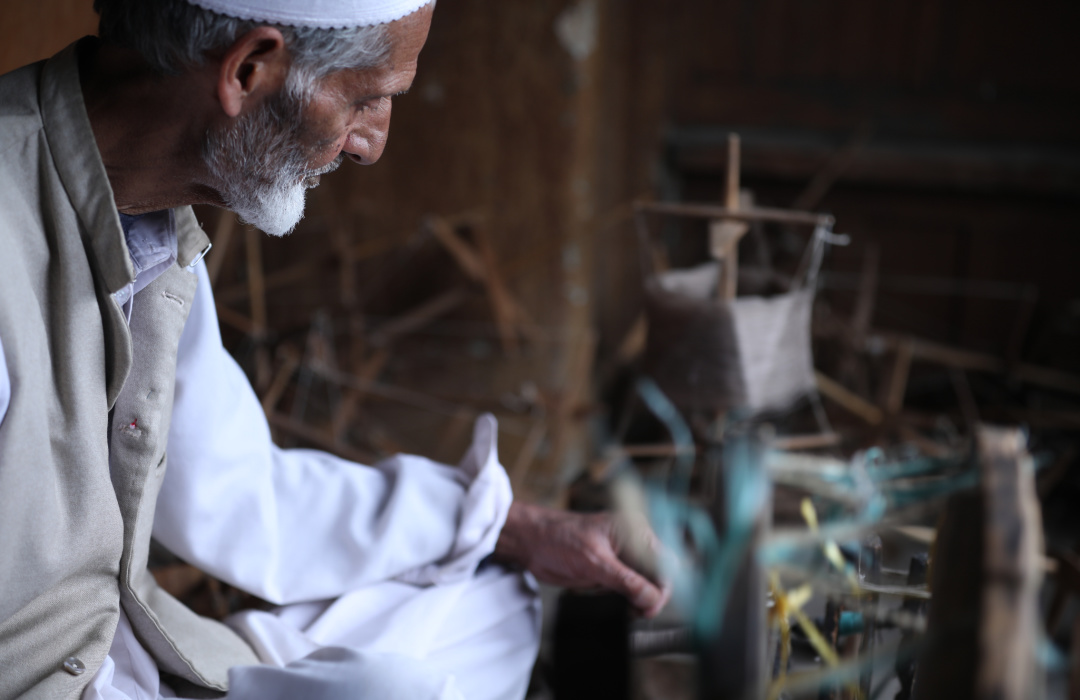
The older generation plays a pivotal role in teaching the nuances of Pashmina craftsmanship. In fact, they are the torchbearers of tradition, holding the secrets of creating the finest threads and patterns. These artisans have spent a lifetime mastering the art. Equally important is their wisdom which is invaluable in ensuring that the essence of Pashmina is not lost.
Within these families, the stories of Pashmina are shared orally, like ancient legends that live on. Anecdotes of challenges faced, innovative techniques developed, and extraordinary pieces created are recounted, ensuring that the past is not forgotten. Simultaneously, these stories serve as inspiration for the next generation of artisans.
The Cultural Significance - Preserving a Way of Life
Beyond the practical skills, family traditions are deeply interwoven with the cultural significance of Pashmina. The craft itself is often regarded as a symbol of cultural identity, especially in regions like Kashmir. These traditions maintain a connection to the roots and values of the community.
The transfer of knowledge isn't just about artisanship but about preserving a way of life. In regions where Pashmina is a primary livelihood, these traditions ensure that the craft remains viable. The bond between generations strengthens the collective identity, and the survival of Pashmina symbolizes the survival of a community.
A Sense of Duty and Pride for the Future
For younger artisans, carrying forward these traditions is a matter of duty and pride. They are aware of the weight of their heritage and the responsibility that comes with it. As they embrace their roles as custodians of this cultural treasure, they also look for ways to innovate and adapt, keeping the tradition alive in a changing world.
The future of Pashmina is closely tied to these family traditions. The passing down of knowledge, skills, and stories ensures that the art remains vibrant and dynamic. Hence the art evolves to meet modern demands, yet holds firm to its cultural roots through the dedication of artisans. It is the artisans who continue to cherish, protect, and enrich their heritage.
Challenges and Triumphs
The path of a Pashmina artisan, though steeped in tradition and cultural significance, is not without its share of trials. In a world of changing markets, economic fluctuations, and modern demands, these artisans have had to adapt and evolve, turning challenges into opportunities and preserving their craft's timeless essence.
Shifting Markets
One of the foremost challenges faced by Pashmina artisans is the unpredictable nature of markets. As Pashmina gained global recognition, it also became subject to market trends and fluctuations. The demand for Pashmina products can vary significantly with changes in fashion and consumer preferences.
Economic Volatility
Economic ups and downs pose another challenge. Artisans often work on meagre incomes, and economic instability can impact their livelihoods. These financial uncertainties have sometimes forced them to seek alternative sources of income or relocate in search of better opportunities.
Competition from Synthetic Materials
The rise of synthetic materials in the fashion industry has also posed a threat. Synthetic imitations, which are often cheaper to produce, have attempted to mimic the allure of genuine Pashmina. The competition from these materials can, at times, affect the market for authentic Pashmina products.
Innovating Tradition
To triumph over these challenges, Pashmina artisans have displayed incredible resilience and adaptability. Also, they've innovated without compromising the core essence of their craft. By introducing contemporary designs and experimenting with new colour palettes, they have further succeeded in broadening the appeal of Pashmina beyond traditional patterns.
Diversification of Products
Recognizing the need to diversify, some artisans have expanded beyond the classic shawls and scarves. Currently, they produce a wide range of Pashmina products, including blankets, wraps, and even clothing. This diversification has not only opened up new avenues for income but also broadened the presence of Pashmina in the global market.
Leveraging Technology
Artisans are also leveraging technology and the internet to reach a broader audience. Through e-commerce platforms and social media, they can connect directly with consumers, bypassing middlemen and ensuring a fairer share of profits.
Community Initiatives
In some regions, artisans have come together to form cooperatives and community-based initiatives. These collaborations provide mutual support, share resources, and enable artisans to access better markets. Such initiatives have often led to improved working conditions and financial stability.
A Resilient Heritage
Through challenges and triumphs, Pashmina artisans have maintained the heritage of their craft. It's their unwavering dedication and adaptability that continue to infuse life into the art of Pashmina weaving. The art remains a testament to the enduring spirit of these artisans and their ability to turn adversity into opportunities.
The Future of Pashmina
In a rapidly globalizing world, where cultural traditions often face the risk of fading into obscurity, the future of Pashmina shines brightly. This timeless craft, deeply rooted in the traditions of the Himalayan region, continues to captivate the modern world with its elegance and heritage.
Contemporary Relevance
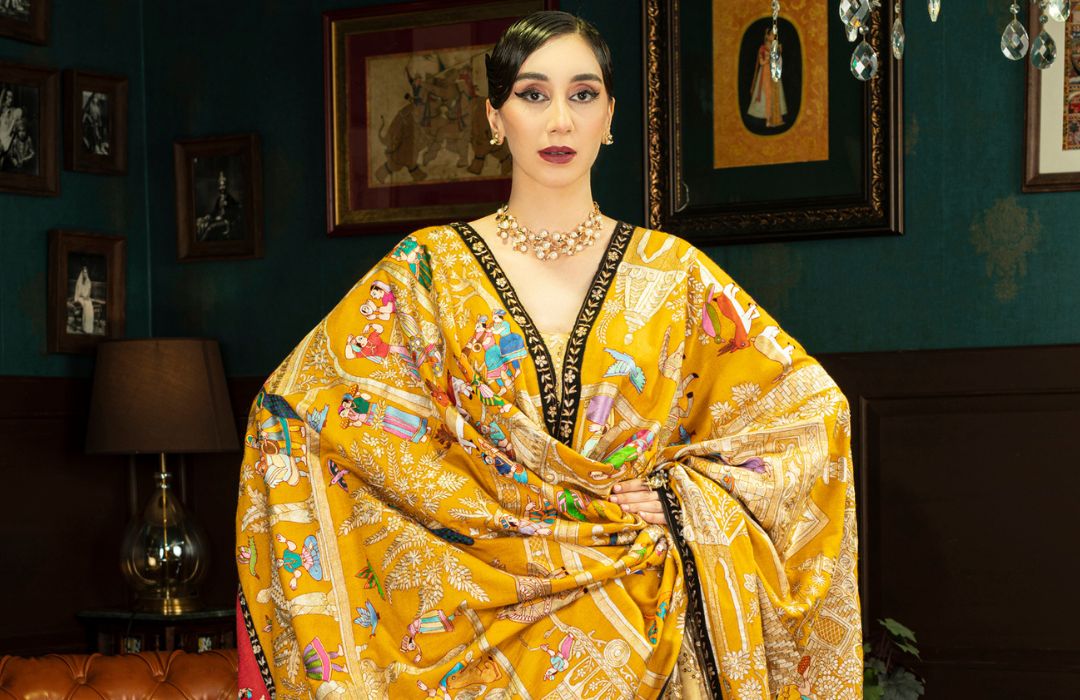
In a world driven by fast fashion and mass production, Pashmina stands as a symbol of slow, sustainable fashion. Its value lies not just in its luxurious texture but also in the centuries-old craftsmanship and cultural significance it carries. As more consumers seek authenticity and sustainability in their purchases, Pashmina finds itself at the crossroads of contemporary relevance.
Pashmina artisans have adapted to changing times by diversifying their products and embracing modern designs, ensuring that Pashmina remains a coveted fashion accessory. Pashmina scarves, wraps, and shawls have found their place in both high-end couture and everyday wardrobes. The versatile nature of Pashmina allows it to seamlessly transition from traditional attire to modern, global fashion.
Preservation and Promotion
Efforts to preserve and promote Pashmina have taken many forms. Artisans and cooperatives are working diligently to protect their craft, ensuring that the art of Pashmina continues to thrive. At the same time, the global community has recognized the importance of safeguarding this heritage.
- Fair Trade Initiatives: Fair trade practices ensure that artisans receive just compensation for their work. This not only improves their livelihoods but also encourages the preservation of the craft.
- Conservation Efforts: Environmental organizations and governments are focusing on the preservation of the Changthangi goats, whose wool is the lifeblood of Pashmina. By ensuring the well-being of these goats, they contribute to the sustainability of the craft.
- Promotion Through Education: Educational initiatives, both locally and internationally, aim to raise awareness about Pashmina. This not only fosters appreciation for the craft but also helps to distinguish authentic Pashmina from imitations.
- Global Fashion Shows: Pashmina has graced the runways of global fashion shows, gaining recognition on the world stage. These appearances highlight Pashmina's place in contemporary fashion and luxury.
The Timeless Thread
As Pashmina weaves its way into the future, it remains a timeless thread connecting tradition and modernity. The cultural heritage of Pashmina is not a relic of the past; it is a living, breathing craft that adapts and thrives. Its contemporary relevance, coupled with the dedication of artisans and conservationists, ensures that Pashmina will continue to adorn the world with its beauty, elegance, and tradition for generations to come.
Conclusion
In the heart of the Himalayas, amidst the breathtaking landscapes and the resilient mountain goats, lies a heritage so rich and vibrant that it weaves not just exquisite fabrics but also stories that transcend time. The cultural importance of Pashmina is a testament to the dedication of its artisans, who have poured their hearts and souls into preserving this legacy.
As we've journeyed through the origins, met the artisans, and explored the craftsmanship of Pashmina, one truth becomes abundantly clear, this is not just an art form. It's a living, breathing tradition that has stood the test of time. Through challenges and triumphs, Pashmina artisans have nurtured and evolved their craft. They have ensured that it remains relevant in a rapidly changing world.
The dedication of Pashmina artisans is a tribute to the strength and tenacity of the human spirit. In a world where trends and fads often dictate our choices, these artisans remind us of the enduring value of authenticity. They encourage us to slow down, appreciate the beauty of meticulous craftsmanship, and respect the heritage that's passed down through their skilled hands.
Also read: A WALK THROUGH THE MEADOWS OF KANI PASHMINA
Buyer's Responsibility
We, as consumers, have the power to further this tradition by recognizing the authenticity and craftsmanship that genuine Pashmina represents. Supporting artisans, cooperatives, and ethical Pashmina producers is not just a purchase; it's a celebration of heritage. It's a way to ensure that this remarkable tradition lives on for future generations to admire and cherish.
So, let's not merely wear Pashmina; let's wear the stories, the culture, and the craftsmanship. Let's acknowledge and support the artisans behind this exquisite fabric. In doing so, we weave a new chapter into the timeless story of Pashmina, a chapter that ensures the enduring thread of Pashmina heritage continues to flourish, even in the face of a rapidly changing world.
Also read: PASHMINA - AN EXPLORATION OF HERITAGE